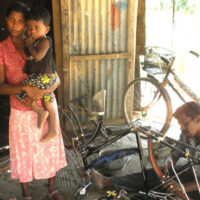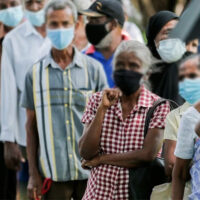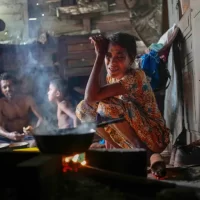Provincial Inequalities in Income and its Distribution in Sri Lanka
Hemesiri Kotagama, Heli De Alwis, Dilshani Ranawaka
“Power has only one duty – to secure the social welfare of people”
Benjamin Disraeli
Introduction: Provincial inequalities in social-economic-political aspects, have been and are significant and sensitive issues, in the development process of Sri Lanka. A reason for the 3 decade long civil war of the past, was infused by provincial inequalities, twined with the fact that ethnic distributions were also unequally distributed among provinces. The north and east provinces, where the war flared on ground, were populated more with Tamils and Muslims and the rest of the provinces populated more by Sinhalese. Nationally, the Sinhalese are the majority on the population count. The civil war ceased in 2009, now (2023) nearing a decade and half since cessation. The expectations for sustained social-economic-political solutions, addressing the root causes of ethno-provincial based social unrest, is yet alive though the civil war ceased. This article examines the current economic (income and its distribution) development status among the provinces in Sri Lanka 15 years since the ethno-provincial war ceased.
Analytical Methodology: This is a simplified presentation of methodology proposed by Food and Agriculture organization in the publication titled: Social Welfare Analysis of Income Distributions Ranking Income Distributions with Generalized Lorenz Curves (https://www.fao.org/3/am390e/am390e.pdf).
In a simplified sense (yet intuitively strong and theoretically well proven) the Social Welfare, is a function of primarily income and its distribution. High income with low inequalities in sharing income provides high social welfare, for a society seeking higher incomes and averse to distributional inequalities. Income is measured by monetary values (such as household income) and income distribution is portrayed by Lorenz Curves (LC) and quantified by Gini Coefficient (GC). A LC closer to the line of equality portrays a more equal distribution of income than a LC below it, if the average income levels represented by the LC are the same. Further if LC intersect which each other the welfare superiority of the LC cannot be determined. Further income distribution is only a singular measure of social welfare and the other being income. It’s the twin of income and its distribution that determines social welfare.
Above problems of comparative measurement of social welfare by using only LC can be overcome by estimating Generalized Lorenz Curve (GLC). A GLC is estimated based on the product of income shares of income groups (such as percentiles) with the average population income (series referred to as shared income), for a given income distribution and average population income. The shared income series is plotted against income share percentiles to portray the GLC. A GLC that is above another is superior in social welfare (representing both income and its distribution) than a GLC below.
In summary, consider two provinces, viz; Western (W) and Northern (N). The Lorenz curves of the two provinces as WL and NL. Then on the singular factor of income distribution, W is social welfare superior over N if:
- If WL is above NL,
- WL and NL does not intersect
- WL and NL represent the same average income.
If above conditions are violated LCs are not a good measure of social welfare. Thus GLC is considered a better measurement of social welfare, as it integrates both factors of social welfare, viz; income and its distribution and since it overcomes above problems as well. If WGLC and NGLC are the GLCs of Western and Northern provinces, respectively, then if WGLC is above NGLC then social welfare in Western province is higher than Northern Province.
Analysis: Table 1 provides data on provincial average household income and its distribution as reported by Department of Census and Statistics based on the Household Income and Expenditure Survey done in 2019.
Table 1. Household Income and its Distribution in Sri Lankan Provinces

Source of data: Household Income and Expenditure Survey (2019) Department of Census and Statistics, Sri Lanka.
Table 2 provides the welfare rankings of the provinces based on income, income equality (Figure 1. LCs of Provinces) and aggregate of income and income equality (Figure 2. GLCs of Provinces).
Table 2. Social Welfare Rankings of Provinces

It is revealed in Table 2, that the Western province has the highest average household income (Rank 1) among all provinces, however its income distribution inequality is the second highest (Rank 8) among the provinces (indicated by the Gini coefficient) and the LCs (Figure 1). However, based on GLC, of integrating income and income equality, Western province Ranks 1 on social welfare (Figure 2). It is apparent that North and Eastern provinces, has lowest mean household income (Rank 8 and 9) and low income inequalities (Rank 2 and 3). However, based on GLC, of integrating income and income equality, North and East province ranks the lowest (Ranks 7 and 8) on social welfare (see Figure 1 for provincial GLCs).
Conclusion: Though, after a decade and half of cessation of war on ground, in North and Eastern provinces , the social welfare levels are still distinctly low. The causes for such differentials in social welfare among provinces, particularly between North-East provinces vis-à-vis others provinces need attention. The causes of low social welfare could be inherent lack of natural capital (fertile land, usable water, etc.), human capital (education), social capital (institutions) and invested capital on infrastructure to provide public goods (schools, roads, hospitals, etc.). Objective analysis on the causes of differential welfare distribution among provinces, could pave way to resolve such differentials. Further long term negligence of such social welfare difference may flair-up social frustration and retard national development.
The TIER (The Inequality Report) is a flagship project undertaken by Centre for Poverty Analysis (CEPA), with YUMA Foundation and Janashakthi Foundation as partner organizations that analyses the state, consequences and reasons of inequality in Sri Lanka and share its findings with the public.
Disclaimer: The views expressed in this article are those of the authors and do not necessarily reflect the views and policies of CEPA

Figure 1. Lorenz Curves of Provinces

Figure 2. Generalized Lorenz Curves of Provinces









